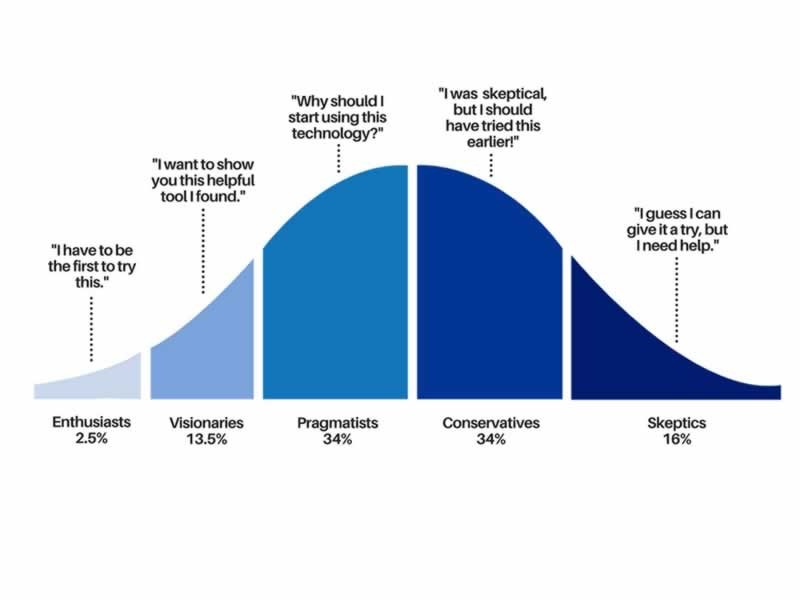Insight Blog
Agility’s perspectives on transforming the employee's experience throughout remote transformation using connected enterprise tools.
14 minutes reading time
(2726 words)
Inside The Rise of ChatGPT & The Rogers Adoption Curve
Analyzing the Rogers Adoption Curve through the Open AI Chat GPT and comparing it with smartphones and social media adoptions.
The Rogers Adoption Curve, the foundational model of how new technology is embraced, is the tool we use to observe the rise of innovative tools like ChatGPT.
ChatGPT, an AI model released by OpenAI, is a state-of-the-art AI system capable of carrying on natural-sounding conversations, providing valuable insights, creating text, and answering questions with unparalleled accuracy. Its influence on various spheres cannot be underestimated; it is transforming how the companies interact with customers, supplementing educational materials, and even changing programming.
Rogers Adoption Curve can be used to analyze the adoption dynamics of ChatGPT and how it will likely impact the different sectors in the future.
Understanding The Innovation Adoption Curve
Innovation Adoption Curve
The Adoption Innovation Curve is a systematic tool that provides a structure by which population groups are categorized based on their willingness to accept new technologies.
This curve is shaped into five distinct segments:
- The first group of buyers is Innovators.
- The second is Early Adopters.
- The third is Early Majority.
- The fourth is Late Majority.
- The last in the group are Laggards.
Every group has a unique feature and this is the way they go about using the recent technologies. Risk-takers are unable to resist the allure of new technologies and are inspired by a desire for exploration.
The Early Adopters act as the social influencers and assist the technologies to spread their word among the larger population in the society where their social status and connections bring significant role here. The Early Majority is the group that likes to watch how things work before they get involved, unlike the Late Majority who needs lots of convincing and sometimes gives in to peer pressure.
Finally, Laggards, until it is impossible not to, resist change that delays the acceptance of new technology until there is no longer any traditional variant. Uncovering these constituencies aids businesses and developers in the preparation of product introduction and marketing campaigns that enhance adoption and market penetration.
How New Technologies Are Adopted Over Time
The first pattern of the new technologies adoption across time is the one that can be predicted based on the Innovation Adoption Curve. At first, Technology Trailblazers lead the way to be followed shortly by the Adopters.
These two groups are crucial because such people can create an informal market and give the technology feedback. When the idea is confirmed, the Early Majority start adopting the technology.
The Late Majority, who may need more near evidence of the technology's utility, will take a step back. Every user that takes up the technology is more than just a customer since they become a testimony of the product's efficacy and acceptance, and this in turn creates a growing number of users until the market either reaches a saturation point or widespread acceptance.
Comprehending this progression is crucial for those who are introducing new technologies, as it impacts decisions pertaining to product development, marketing, and resource allocation, which in turn, enables a holistic approach that encompasses the whole curve and drives maximum adoption at each stage.
Understanding Rogers Diffusion of Innovation Theory
| Element |
Description |
| Innovation | Innovation encompasses a wide range of concepts, depending on the existing knowledge within the analyzed unit. Anything perceived as new by an individual or another adopter can be categorized as an innovation worthy of examination. |
| Adopters | Adopters serve as the fundamental unit of analysis. While most studies focus on individual adopters, they can also encompass organizations (such as businesses, schools, or hospitals), clusters within social networks, or even entire countries. |
| Communication | Diffusion inherently involves the interaction between people or organizations. Communication channels facilitate the exchange of information from one entity to another. At the very least, there must be established communication patterns or capabilities between parties for diffusion to take place. |
| Time | The adoption of innovations typically requires the passage of time and is rarely instantaneous. For instance, in the Ryan and Gross (1943) study on the adoption of hybrid corn, the process spanned over a period of more than ten years. Additionally, during the initial years following adoption, most farmers only allocated a small portion of their fields to the new corn. |
| Social system | The social system comprises both external influences, such as mass media, organizational directives, or governmental mandates, and internal influences, including strong and weak social connections and proximity to opinion leaders. Within the social system, various roles exist, each contributing to the overall influence on a potential adopter. |
Rogers Diffusion of Innovation Theory
The Rogers Diffusion of Innovation Theory, proposed by Everett Rogers in 1962, provides a valuable approach for understanding not only the how and why new ideas, products, and technologies spread among a population but also the theories behind it. This theory postulates the social mechanisms that determine the rate of adoption of innovations and divides people into different categories of adopters based on the readiness to adopt new things.
Through the study of the attributes and behavioral patterns of each adopter group, the theory serves to provide useful insights into the diffusion process and determine the strategies that popularize the innovation among masses.
Origins of the Diffusion of Innovation Theory
Robert Everett Rogers is widely known as the author of the Diffusion of Innovation Theory, which was initially based on studies of the adoption of agricultural innovations in rural areas.
Creating his theory by means of experimental research with different groups of people, Rogers discovered the way innovations are diffused among different communities. Its landmark paper, "Diffusion of Innovations", now serves as the backbone for understanding how innovations are picked up and spread out in different systems, from agriculture to healthcare to technology.
Key Components of the Theory
The Diffusion of Innovation Theory identifies five key components that shape the diffusion process: relative advantage, compatibility, complexity, trialability, and visibility.
The notion of comparative advantage highlights a situation where an innovation is seen as better than the current alternatives. Compatibility is one of the key factors that examines how new innovation matches with the existing beliefs, norms and behaviors of the target audience.
Complexity analyzes the problem of the level of understanding and applicability of the innovation.
The Trialability as such is a chance for people to have a try at the innovation and then to go on using it, but the Observability points at the visibility of the advantages which the innovation brings to others. Components of these two models, such as perception, understanding, and behavior in the process of adopting new technologies, are interconnected and determine how individuals perceive and adopt them.
The perception of how these components determine the extent of adoption by various adopter groups is critical for both predicting and managing technology adoption. For instance, innovators and early adopters are likely to be persuaded by the relativity advantage and observability of innovation, while the early and late majority will pay attention to its compatibility and ease of trial. Through matching the features of innovation with the demands and aspirations of each adopter group, organizations can address the specific needs of the society via this method.
Follow us and access great exclusive content everyday: Follow us on Google News
The Diffusion of Innovation Process
Rogers' Diffusion of Innovation Process explains the journey that begins with the idea, technology, or practice being introduced into a society and continues through its permeation into the fabric of the society. This framework creates a roadmap of how an innovation is accepted by a population, from its initial introduction to the time when it is widely embraced, and shows the forces that facilitate its spread.
This process is tightly combined with other things that become the basis of the pace and scope of the adoption which will determine the influence level of the innovation on society.
Some of these factors are the attributes attributed to an innovation itself, the type of decision the individuals are facing, the kinds of communication channels being used, the social structure in which adoption occurs, and the efforts exerted by change agents in promoting the innovation.
Under the right circumstances, diffusion strategies can prove to be the roaring engines that drive innovation.
1.Awareness
The first stage in the diffusion of innovation is awareness. At this point, potential adopters are introduced to the innovation but lack sufficient information to make a purchasing decision. Marketers focus on increasing awareness and providing education to encourage further exploration.
An old adage aptly captures this stage: "If the user can't find it, it doesn't exist." Marketers strive to ensure their innovation is visible and accessible to potential adopters.
2.Persuasion
Once potential adopters become open to the idea of purchasing, they enter the persuasion stage. They actively seek information to inform their decision-making process. Marketers aim to highlight the benefits of the innovation in detail, making a conscious effort to sell the product or idea.
During this stage, there's a focused effort to convince individuals of the value and advantages offered by the innovation. Marketers tailor their messaging to address the needs and concerns of potential adopters.
3.Decision
The decision stage is where potential adopters must make a choice. They weigh the pros and cons of adoption before either accepting or rejecting the innovation. This stage is often the most challenging to understand, as decision-making processes can be complex and influenced by various factors.
Rogers highlights this stage as particularly opaque, as people don't always make rational decisions. Instead, decisions may be based on underlying perceptions and emotions, with individuals rationalizing their choices afterward. Thus, gaining insight into the decision-making process can be difficult, as stated reasons may not accurately reflect the true motivations behind decisions
4.Utilization
Once the decision to adopt a product is made, the purchaser typically begins using the product. During this stage, the adopter assesses the product's utility and effectiveness in meeting their needs. They may also seek additional information to support their usage or gain a deeper understanding of the product's functionalities.
This phase underscores the importance of considering the post-sale ownership experience. Designers and marketers must ensure that users have access to relevant information after purchase. The quality of the implementation process hinges on the accessibility and reliability of this information.
5.Validation
Validation occurs when the user evaluates their decision to continue using the product or consider discontinuation. This phase persists until the user either abandons the product or continues its usage. For instance, when purchasing a new car, one is likely to use it for several years before eventually replacing it.
During validation, users conduct both personal and social assessments of the product. They may seek validation from peers, colleagues, or friends to affirm their decision to continue using the product.
OpenAI & Other Adoption Curve Examples
The Adoption Curve examples show how different technologies develop momentum and gradually become the norm among the user group. A pertinent case study is OpenAI's development of ChatGPT, analyzed through the lens of the Rogers Adoption Curve, which classifies adopters into five categories: In this case of the Innovators, Early Adopters, Early Majority, Late Majority, and Laggards.
ChatGPT by OpenAI first caught the Innovators, the tech-savvy and AI researchers who were thrilled by the opportunities that such AI chatbots presented. This was proven by the fact that it had a number of practical applications from automated customer service to content creation, and it moved into the Early Adopters phase. This group started to put the chatbot to work for more purposes than just experimentation as it realized its higher potential in various sectors of the professional world.
Contrarily, smartphone adoption got sped up when the technology headed to a necessity in daily life after it had been a luxury item. Innovators were the first ones who used smartphones in their big and expensive sizes, followed by Early Adopters who benefited from smartphones as far as their connectivity and multimedia capabilities are concerned. With technological advancements and corresponding drops in prices, smartphones have rapidly crossed over the Early and Late Majority stages of diffusion, and they are now common globally.
The same phenomenon was also observed in other social media sites such as Facebook and twitter as their adoption curve was also quite prominent From the beginning, the Innovators, who utilized social media for niche networking, have been followed by the Early Adopters among the masses and celebrities, which in turn has increased the visibility and attractiveness of the social media platforms. The network effect started to be felt, bringing these platforms through early and late adoptions and ultimately creating a situation where almost everyone using the internet is engaged in social media.
In the light of the development of ChatGPT, this is where it is observed that the platform is progressing to the Early Majority, as the use of it by businesses and educational institutions in improving productivity and engagement is recognized by many. The path shows the possibility of crossing into the Late Majority as integration into daily activities become more natural and UI's develop their designs.
Benefits of The Diffusion of Innovations theory
The Diffusion of Innovations theory offers several key benefits:
- Predictive Capability: This theory provides a structured framework for forecasting and comprehending the diffusion patterns of innovations. By analyzing factors such as the innovation's attributes, adopter categories, and communication channels, it becomes possible to predict the rate and scope of adoption accurately.
- Tailored Approaches: By recognizing various adopter categories and their unique characteristics, the theory enables the development of targeted strategies to promote innovation adoption. Customized interventions can address the specific needs and concerns of each group, enhancing the likelihood of successful adoption outcomes.
- Informing Policy and Decision-Making: Policymakers and decision-makers can leverage the insights provided by this theory to better understand the dynamics of innovation adoption. By identifying barriers to adoption, evaluating potential risks, and crafting effective policies, incentives, and interventions, they can facilitate the diffusion process more effectively.
Limitations of The Diffusion of Innovations theory
The Diffusion of Innovations theory, while valuable, presents certain limitations that warrant consideration and expansion:
Expanding the theory to address these limitations could enhance its utility in understanding and promoting innovation diffusion in complex social environments. Incorporating a more nuanced understanding of adoption processes, acknowledging structural influences, and accounting for contextual variability can enrich the theory's predictive power and practical application.
- Oversimplified Adoption Process: One limitation lies in the theory's tendency to simplify the adoption process, assuming it follows a linear and rational trajectory. However, adoption decisions are often influenced by multifaceted social, cultural, and emotional factors that the theory may not fully encompass.
- Neglect of Structural Influences: Another limitation is the theory's narrow focus on individual-level factors and communication dynamics, overlooking the impact of structural elements, power dynamics, and inequalities. These structural factors can profoundly shape adoption patterns and create barriers for certain segments of the population.
- Contextual Variability: Additionally, the theory may need to better accommodate contextual variations in the diffusion process. Adoption dynamics can differ significantly across various innovations, social systems, and cultural contexts. Therefore, the theory may require adaptations and refinements to ensure its relevance and applicability across diverse settings.
Expanding the theory to address these limitations could enhance its utility in understanding and promoting innovation diffusion in complex social environments. Incorporating a more nuanced understanding of adoption processes, acknowledging structural influences, and accounting for contextual variability can enrich the theory's predictive power and practical application.
You may also like: Best Apps for Employees: UPDATED 2022 – A Complete Guide
Free ebook: How To Get Your Intranet Off The Ground
Wrapping up
Looking at the launch of ChatGPT by OpenAI against smartphone and social media technology adoption of old times helps understand the technology adoption process and diffusion. The Rogers Adoption Curve serves as a relevant tool that sharpens our understanding of the processes involved. It stresses out how user experience is at the heart of any successful innovation.
As ChatGPT is expected to follow the path of past successful technologies, the adoption of this technology will be emphasized by the accessibility factor and practicality, thereby showing that these two are the main factors that will make the technology popular with all the segments of the society.
Categories
Blog
(2596)
Business Management
(318)
Employee Engagement
(206)
Digital Transformation
(173)
Intranets
(119)
Growth
(118)
Remote Work
(61)
Sales
(48)
Collaboration
(37)
Culture
(29)
Project management
(29)
Customer Experience
(26)
Knowledge Management
(21)
Leadership
(20)
Comparisons
(5)
Ready to learn more? 👍
One platform to optimize, manage and track all of your teams. Your new digital workplace is a click away. 🚀
Free for 14 days, no credit card required.
















